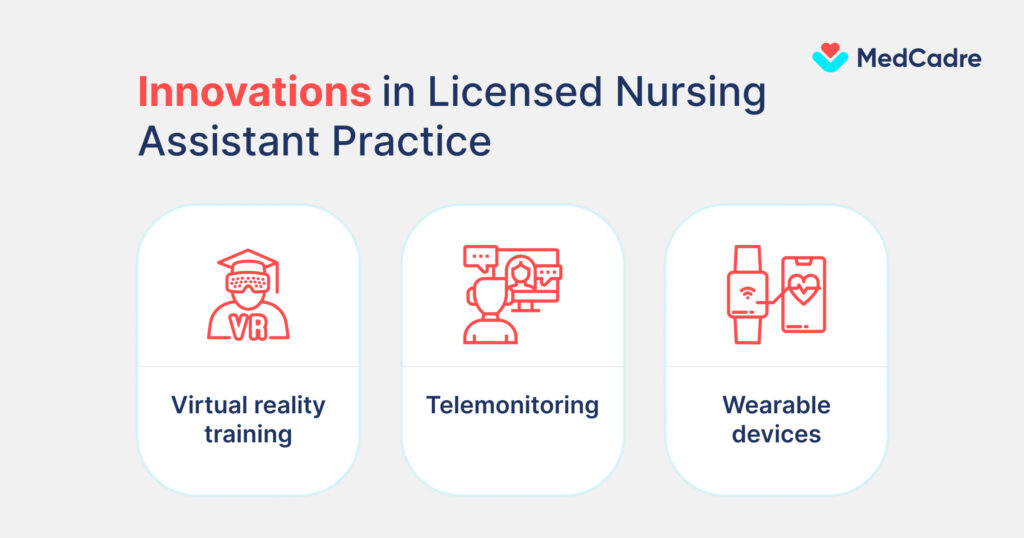LNA also called Licensed Nursing Assistant is one of the most important roles in the healthcare sector, they provide direct patient care and ensure the well-being of patients each day. However, the industry is continuously growing and innovation comes as part of it, and it stands as an opportunity as well as a challenge for Licensed Nursing Assistant Practice.
So today we are going to learn the current trends and innovations that are going on in the healthcare industry for Licensed nursing assistant practice, through this blog we will try to cover all the valuable insights that are going on in the healthcare industry for LNAs.
Workforce shortage while demand is rising
One most noticeable trend we are seeing is an increase in demand in the healthcare sector for Licensed Nursing Assistant Practice. The aging population and increasing healthcare needs have prompted the search for skilled individuals who can help nurses and other healthcare workers when needed.
“LNA job possibilities are predicted to expand by 13% by 2030- Bureau of Labor Statistics.”
Despite the increase in demand for Licensed nursing assistant practice in the healthcare sector, the industry is facing major shortages, which is resulting in an extremely competitive labor market nowadays.
This shortage highlights the need to develop an effective way of attracting and retaining talent in this sector. This problem is not just for retaining and hiring but also to make them stay for a long time and skilled healthcare workforce.
Increasing focus on patient-centered care
The healthcare business is changing to a patient-centered care approach. This stresses personalized care programs tailored to each patient’s unique needs and preferences. Licensed nursing assistant practice play an important role in this paradigm because they promote positive patient relationships, provide emotional support, and ensure a comfortable and safe atmosphere. LNAs’ ability to communicate effectively, empathize, and understand cultures is becoming increasingly vital.
Technological advancements
Technology is transforming the healthcare setting and digital healthcare innovations, and Licensed Nursing Assistant Practice are no exception. Electronic health records (EHRs) are becoming the norm, necessitating LNAs’ familiarity with data entry and retrieval. Furthermore, assistive technology such as wearable monitors and automated medicine delivery systems are being used to improve patient care while reducing LNA workloads. Accepting these technology improvements can help LNA practitioners improve efficiency and accuracy.
Specialization and delegation
As the healthcare industry becomes more complex, specialization is becoming more common. LNAs are taking on specific duties in a variety of contexts, including geriatrics, pediatrics, and wound care. This necessitates extra training and certification, which enables LNAs to broaden their skill sets and contribute to specific patient populations. Another tendency is to delegate responsibilities from nurses to competent LNAs, which allows nurses to focus on more difficult areas of patient care.
Continued education and professional development
LNAs must continue to learn throughout their careers to stay relevant and adapt to changing industry requirements. Many employers offer continuing education programs to help LNAs maintain their licenses and improve their skills. Professional organizations also provide workshops, conferences, and online resources to assist people advance professionally. Continuously learning new skills and staying current with the latest advances demonstrates commitment and attention to the field.
Digital healthcare innovations in LNA practice
Beyond these LNA technologies & trends, some captivating innovations influence LNA practice and digital healthcare innovations. Here are some examples:

Let’s learn the above three in a little brief:
- Virtual reality (VR) training: VR simulations can provide realistic and immersive training experiences for LNA technology, allowing them to practice skills in a safe and controlled environment.
- Telemonitoring: Remote monitoring tools can allow LNA technology to track patients’ vital signs and report changes to nurses, improving patient care continuity and reducing unnecessary hospital visits.
- Wearable devices: Wearable technology can empower LNA technology to monitor patient activity levels, sleep patterns, and other vital signs, providing valuable data for personalized care plans.
How technology and trends are fueling the demand for LNA
The healthcare field is transforming, and one of the biggest beneficiaries might be Licensed Nursing Assistants (LNAs). While technology is often seen as a potential threat to jobs, in the case of LNAs, it’s creating a surge in demand. Let’s explore how:
Tech-driven care: Advancements in medical technology are allowing for more complex procedures to be performed, leading to a higher acuity level (severity of illness) in patients. This creates a need for more hands-on care, which LNAs can provide under the supervision of nurses. Additionally, technology can free up nurses’ time for more complex tasks, allowing them to delegate essential but routine care to LNAs.
Remote patient monitoring: Telehealth and remote patient monitoring are becoming increasingly popular. LNAs can play a crucial role in this trend by assisting patients with using these technologies and monitoring their vital signs at home.
Increased focus on patient experience: The healthcare industry is placing a greater emphasis on patient satisfaction and creating a positive experience. LNAs are often the primary caregivers patients interact with, and their ability to provide compassionate care is invaluable.
The numbers speak for themselves:
- The BLS predicts a 19% growth in Licensed Nursing Assistant positions from 2022 to 2032, which is much faster than the average for all occupations (projected at 4%).
- This translates to an estimated 903,400 new jobs for LNAs over the next decade.
Technology and trends in healthcare are creating a perfect storm for increased demand for LNAs. Their role is becoming even more crucial as the healthcare system evolves. With a growing elderly population, a focus on patient experience, and the rise of remote care, LNAs are poised to be in high demand for years to come.
In the future, there will be a significant increase in demand for licensed nursing assistants (LNAs). As technology progresses, the need for skilled LNAs will also rise. Agencies such as MedCadre play a pivotal role in assisting individuals in finding suitable LNA positions in the USA. With over 500 job listings on their website, follow the steps defined below::
- Visit the MedCadre website.
- Browse through the available LNA positions and select one that meets your requirements. Click on “Apply Now.”
- Complete the application form and upload your CV.
- Our team of recruiters will then reach out to you to proceed with the next steps.
The future of LNA practice
The future of LNA practice is likely to be shaped by two key forces: advancing technology and an emphasis on patient-centered care. Technological innovations like remote patient monitoring and medication dispensing systems will free up LNAs to spend more time with patients, providing companionship and emotional support. Additionally, a growing focus on preventative care may see LNAs playing a larger role in health education and wellness initiatives. To thrive in this booming industry, LNAs can expect to see continued emphasis on ongoing education and the development of new skills, ensuring they remain at the forefront of quality care delivery.

